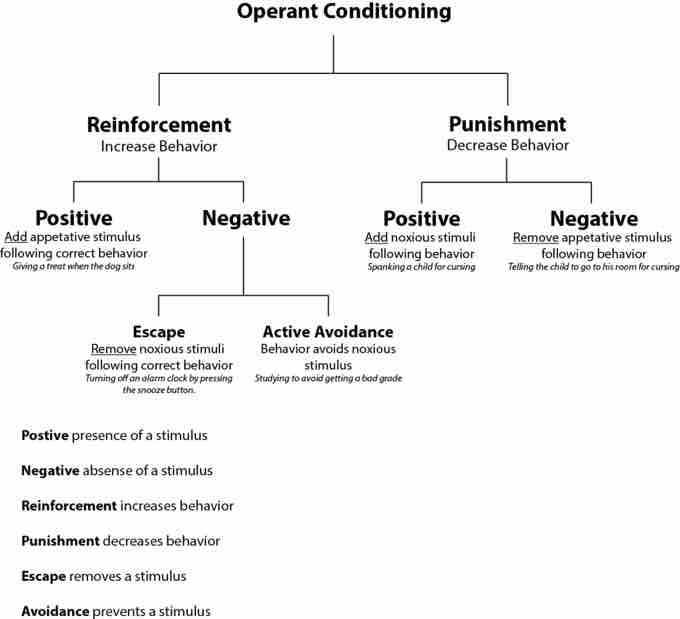The basic premise behind B.F. Skinner's Theory of Reinforcement is both simple and intuitive: an individual's behavior is a function of its consequences. Think of it as a simple cause and effect graph. Every behavior will be a cause that creates some sort of consequence as an effect. If I work hard today, I'll make more money. If I make more money, I'm more likely to want to work hard. This creates behavioral reinforcement, where the desired behavior is enabled and promoted by the desired outcome from a behavior.
The Primary Inputs
This theory relies on four primary inputs or aspects of operant conditioning, generated from the external environment. These four inputs are positive reinforcement, negative reinforcement, positive punishment, and negative punishment. A fifth input could be described as extinction, which is a lack of reinforcement for a behavior that had previously been reinforced.

Operant Conditioning
This chart demonstrates the various facets of operant conditioning, which can be framed via reinforcement and punishment (both positive and negative for each).
Reinforcement
Positive reinforcement: When a behavior (and subsequent response) is rewarding, the frequency of that behavior will be increased. For example, if an employee identifies a new market opportunity that creates profit, an organization may give her a bonus. This will positively reinforce the desired behavior.
Negative reinforcement: When a desired behavior is responded to with the removal of something the individual doesn't like, the behavior is reinforced. For example, an employee demonstrates a strong sense of work ethic and wraps up a few projects faster than expected. This employee happens to have a long commute. The manager tells the employee to go ahead and work from home for a few days, considering how much progress she has made. This is an example of removing a negative stimuli for reinforcing a behavior.
Punishment
Positive punishment: Conditioning at it's simplest, punishment is simply identifying a negative behavior and providing an adverse stimuli to dissuade future instances. A simple example would be suspending an employee for inappropriate behavior.
Negative punishment: Similar to negative reinforcement, negative punishment revolves around removing something to condition a response. To use our previous example for negative reinforcement, an employee prefers to work at home. However, his performance has been suffering lately. A negative punishment would be to revoke the right to work at home until performance improves.
Factors Impacting Success
Reinforcement can be impacted by various factors:
Satiation - In short, the degree of need. If an employee is quite wealthy, for example, it may not be particularly helpful to offer a bonus.
Immediacy - The time between the desired behavior and the potential reinforcement will have impact on how significantly the reinforcement will be correlated with the behavior. To use the bonus example, if an employee does something great, don't wait around to provide a bonus. Make sure it's fresh in their minds; this helps associate the outcome cause with the effect.
Size - Of course, the scale of the reward or punishment has a big impact on the scale of the response. A bigger bonus means a bigger impact (to a degree, see the satiation aspect above).